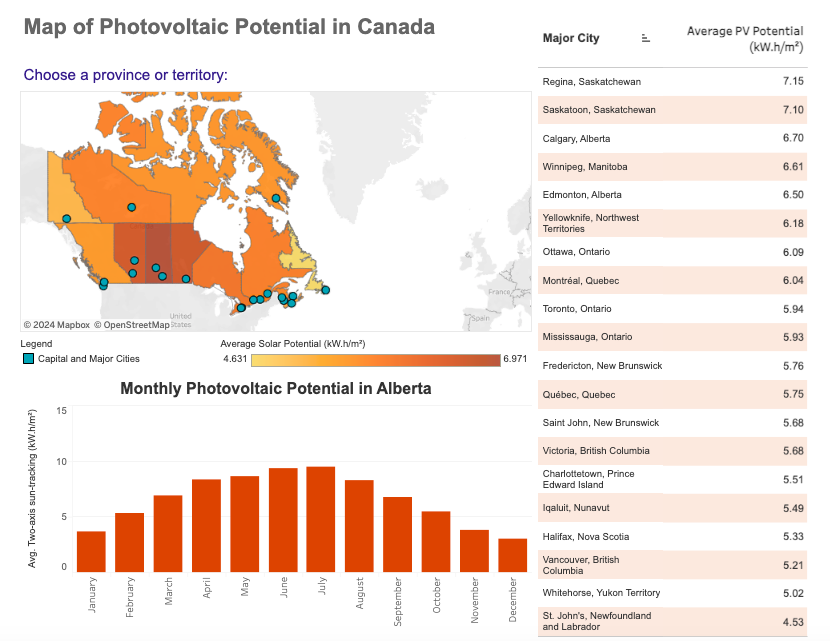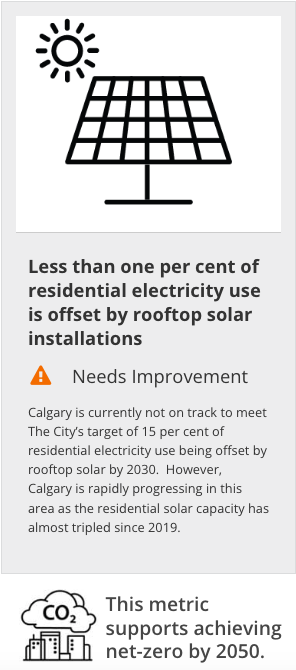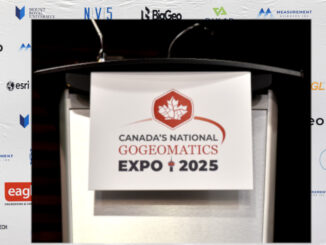
Securing a reliable energy source in the modern age will consistently be one of the biggest problems people will have to face. Renewable energy has hit a point of being seriously considered in terms of effectiveness and cost. Examples such as solar, wind, and hydro are some of the leading sources of renewable energy. Solar seems to be the most versatile of the three. This article aims to focus on solar energy and how geospatial tools can help optimize installations and other key points of the process. We will use the City of Calgary as a case study of an established large city that has seen exponential population growth in recent years and has the potential to be a leading example for solar energy integration.
Solar Potential Calculations
The city of Calgary has put together a solar potential calculator. This is a fantastic first step in determining the viability of integrating a solar energy system with the current electrical grid. The calculator itself is a simple three-step process and is accessible to the public, as seen in this link: (Residential Solar Calculator – City of Calgary). By using geospatial tactics, a large database of information can be stored, sorted, and queried. By taking advantage of this Arcpro database, individual homeowners can look up the specific statistics their house has and can aid in the decision-making process before committing to installing solar panels.

The dataset demonstrates the optimal size of a Photovoltaic, PV, system installed on residential rooftops. “The analysis uses LiDAR data taken in 2018 to estimate solar irradiance and roof shape to estimate the number of 1m x 2m solar panels. This data is then used with PVWatts API created by NREL to estimate the annual AC generated per panel. Each address has one or more entries each representing a continuous area where panels could be installed.” (Residential Solar Photovoltaic (PV) System Potential – City of Calgary). The City of Calgary has also acknowledged that since solar panels are a fairly new product for residents to look into, they have provided an early-stage Questions/Answers page to help those interested. (Solar Energy & Photovoltaic Systems – City of Calgary). The page has helpful links that direct you to help with permits and approvals, current solar projects, and climate action strategies.

Calgary is also one of the sunniest cities in Canada. With an average of 333 days of sunshine per year, there is a lot of potential energy to be utilized (lifeincalgary – Calgary Economic Development). With an average of 6.70 kW.h/m^2, Calgary is only outshined by Saskatoon and Regina with 7.10 and 7.15 kW.h/m^2 respectively (Market Snapshot: Which cities have the highest solar potential in Canada? – Canada Energy Regulator). By using statistical data paired with a geospatial application, this places Calgary as a hub for solar energy investment.

Infrastructure, Residential Installations, and Geospatial Optimization
One of the biggest hurdles The City of Calgary and its residents will face with solar panel installations is establishing and maintaining the infrastructure demand that solar energy will bring. The first step is to integrate solar energy with the current grid system. Although not particularly daunting, it is costly and time-consuming to get started.
Geospatial data can be utilized to help predict energy demand and optimal transmission routes. Predicting energy demand focuses on making the highest net solar potential areas the focus targets of setting up panels. Higher energy yields can be attained early on, potentially offsetting the project’s cost, and giving more traction to set up more solar panels. Statistics for different seasons and the time of day should also be considered for peak consumption rates. Using geospatial tools to get the grid statistics and map peak hours can help optimize how the solar portion of the electrical grid is used.
For optimal transmission routes, geospatial analytics can find the most efficient routes by utilizing electrical grid mapping of the city. Without going too much into detail, the mapping applications can get the highest yield of energy by finding the shortest route from the solar panel to the user or grid storage batteries.
This being an ever-growing, multi-year process, the hardest part will be determining the budget and goal post timelines for the city. As it stands right now, “Calgary is currently not on track to meet The City’s target of 15 percent of residential electricity use being offset by rooftop solar by 2030. Calgary is rapidly progressing in this area as the residential solar capacity has almost tripled since 2019.” (Installed rooftop solar capacity – City of Calgary).

Installed rooftop solar capacity – City of Calgary
As for residential, it comes down to the homeowner. The cost will be a major deterrent for the vast majority of homeowners, especially if there are maintenance costs to look at. The average middle-class homeowner will most likely be unable to afford solar panels purely on government rebates and would otherwise have to take a specific loan. The Residential Solar Calculator also considers this and can help with the decision-making when understanding if the homeowner is in an optimized location by utilizing open-source geospatial tools at their disposal.
Another problem to consider is the cost of repairing broken components for solar panels. That’s why appropriate tax subsidies to those who can install solar panels must be integrated appropriately to establish more of a reward system rather than punishment, similar to the carrot and stick analogy. A new system will have to be integrated for the re-sale of homes with solar panels installed. Until all homes have solar panels installed, this will inflate the cost of homes that have panels installed to a certain percentage (Do solar panels add value to residential property – globe-net). This will add an entirely new element to the housing situation in Canada and should be looked at with care, especially given the current housing situation as of writing this article. Geospatial data analysis can aid in the projections of this market shift to a degree given enough time projections and data input.
Challenges with solar energy possible mitigation using geospatial tools
Solar Panel Installation:
Rebates help, but the cost of installation for Albertans averages between $15,000 – $30,000 before grant funding incentives (How Much Does it Cost to Install Solar Panels in Alberta? – Evalence). Most middle-class homes cannot afford this. There needs to be some action taken to help reduce the cost. With Alberta’s connection to the energy industry, leadership should consider focusing on manufacturing and implementation. By building solar panels within Canada, Calgarians and Canadians, can take advantage of this market and localize it without worrying about import costs. Visually representative mapping paired with accurate data can help with finding the best options to install new solar panels.
Cost of Maintenance:
Inspection, cleaning, and repairs are the main three costs of maintenance. All three help maximize the solar panels’ potential, so upkeep is a very important factor. Calgary’s dynamic weather patterns will surely make maintenance costs high from all the snow, wind, and hail. With high maintenance cost comes managing resource extraction to replace components (How much does it cost to maintain your solar panels? – FIXR). Having a risk factor map for homes is potentially something that is missing. This can be established with historical data for weather patterns and mapping this data to see where harsh weather conditions occur more frequently. These reports can be added to a household’s risk assessment and can help determine the cost of solar panels as well as other insurance.
Resource Extraction & Waste:
The materials needed for solar panel production require a lot of mining for unique materials. With 19 mineral products and metals, 8 of which are designated “critical materials,” the cost of resource extraction will be fairly high. Especially in the implementation phase. This also means there will be supply challenges, “… such as a small global market, a lack of supply diversity, market complexities caused by co-production, and geopolitical risks (Mining for Clean Energy – Clean Energy Canada).” This quote alone tells you the large-scale requirements needed to begin solar panel production. Geomatics is very present in the mining industry, and the geospatial tools used can help optimize where and how these resources can be mined.
Calgary’s strong ties to the energy industry will be its biggest asset in pushing this massive project. Oil and gas is the predominant energy source in today’s market. Calgary’s strong connection to this industry allows it to use these connections with energy to efficiently and effectively combine the two. This collaboration and ease of integration is necessary in reducing emissions and transitioning energy sources.
Final Thoughts & Questions
- Solar should be Calgary’s next big energy step. With a very strong connection to the energy sector, it would be a missed opportunity not to take advantage of this situation given the near-perfect conditions of Calgary’s physical and economic geography.
- Using geospatial data to optimize installations for the best-fit areas will promote further projects. The success of these projects can best be determined through an environmental impact assessment.
- Calgary’s entrepreneurial spirit and growing international reputation will hopefully bring some means of accelerating the renewable energy market as well as some keen geospatial minds to bring new ideas forward.
- For a final question for the readers: How do you see the City of Calgary breaking through the major hurdles of solar energy integration while optimizing geospatial tools?
Referenced articles and webpages:
Residential Solar Calculator – City of Calgary
https://www.calgary.ca/environment/programs/residential-solar-calculator.html?redirect=/solarcalculator
Residential Solar Photovoltaic (PV) System Potential – City of Calgary
https://data.calgary.ca/Environment/Residential-Solar-Photovoltaic-PV-System-Potential/k85e-i265/about_data
Solar Energy & Photovoltaic Systems – City of Calgary
https://www.calgary.ca/environment/programs/solar.html
life in Calgary – Calgary Economic Development
https://www.lifeincalgary.ca/
Market Snapshot: Which cities have the highest solar potential in Canada? – Canada Energy Regulator
https://www.cer-rec.gc.ca/en/data-analysis/energy-markets/market-snapshots/2018/market-snapshot-which-cities-have-highest-solar-potential-in-canada.html#:~:text=Of%20the%20major%20cities%2C%20Regina,5.68
Installed rooftop solar capacity – City of Calgary
https://www.calgary.ca/environment/climate/installed-rooftop-solar-capacity.html
Do solar panels add value to residential property – globe-net
https://globe-net.com/do-solar-panels-add-value-to-residential-property/#:~:text=As%20it%20turns%20out%2C%20the,a%204.1%25%20gain%20in%20value
How Much Does it Cost to Install Solar Panels in Alberta? – Evalence
https://www.evalence.ca/blog/solar-panel-cost-alberta#:~:text=The%20average%20cost%20to%20install,%2430%2C000%20before%20grant%20funding%20incentives
How much does it cost to maintain your solar panels? – FIXR
https://www.fixr.com/costs/solar-panel-maintenance
Mining for Clean Energy – Clean Energy Canada
https://cleanenergycanada.org/wp-content/uploads/2017/06/MiningCleanEnergy2017.pdf





Be the first to comment